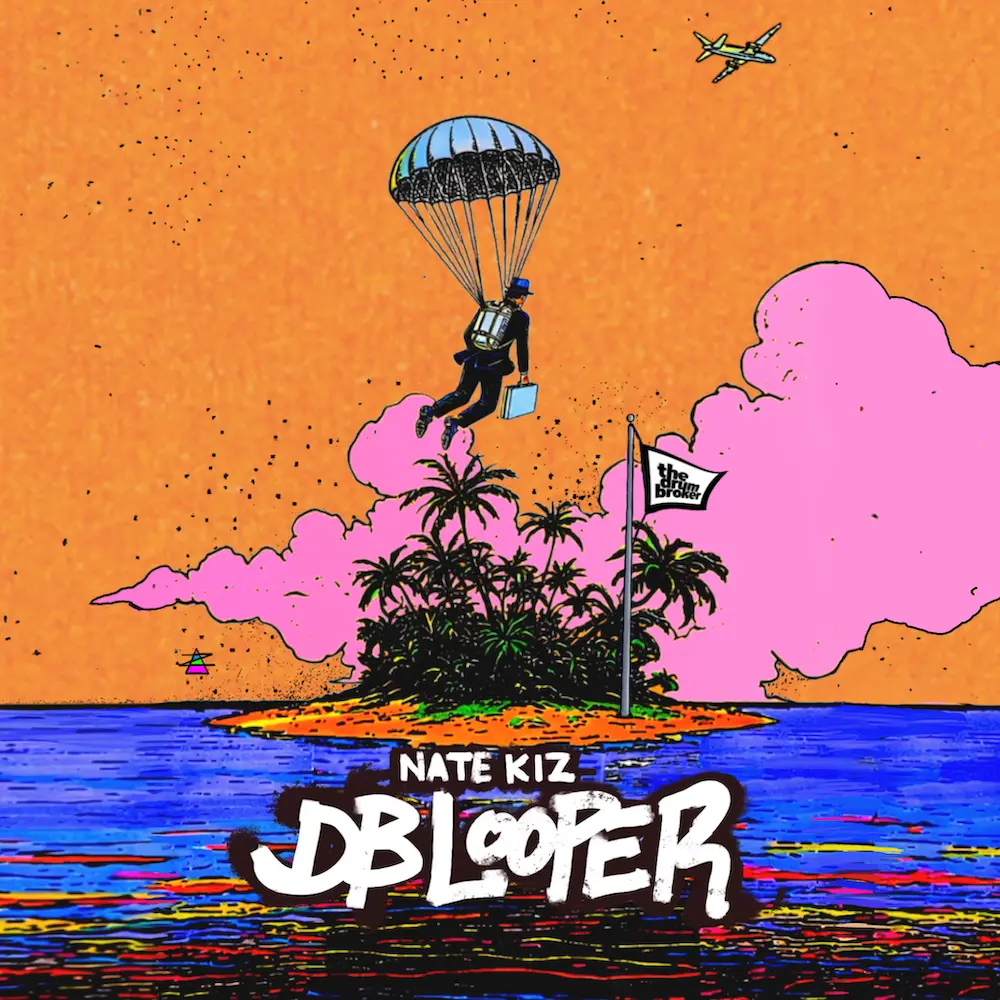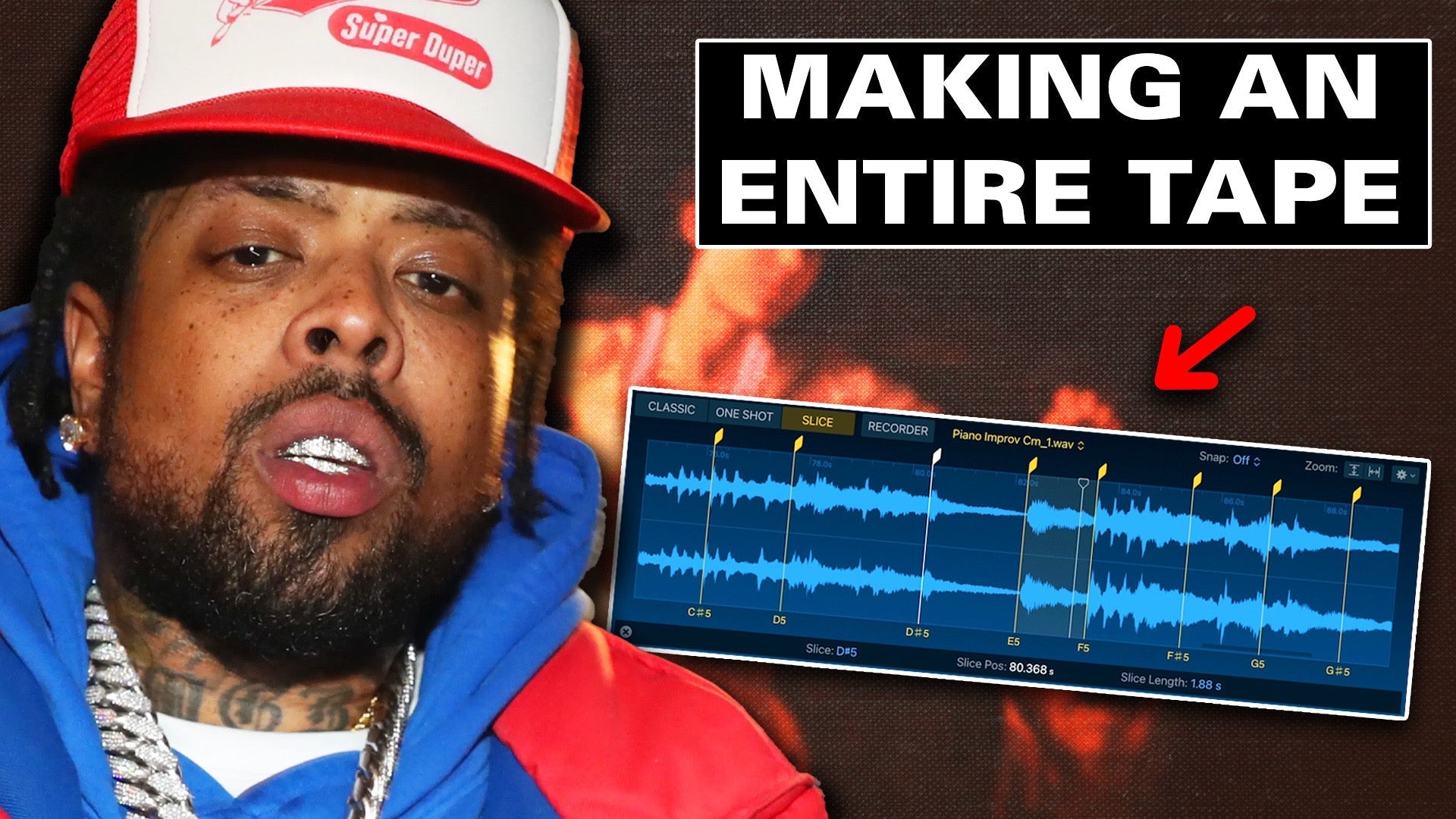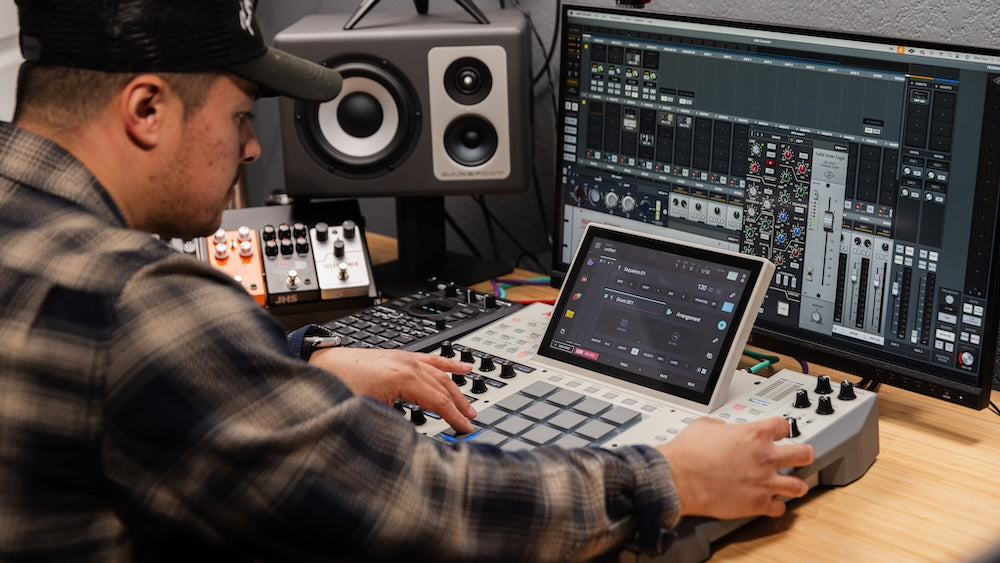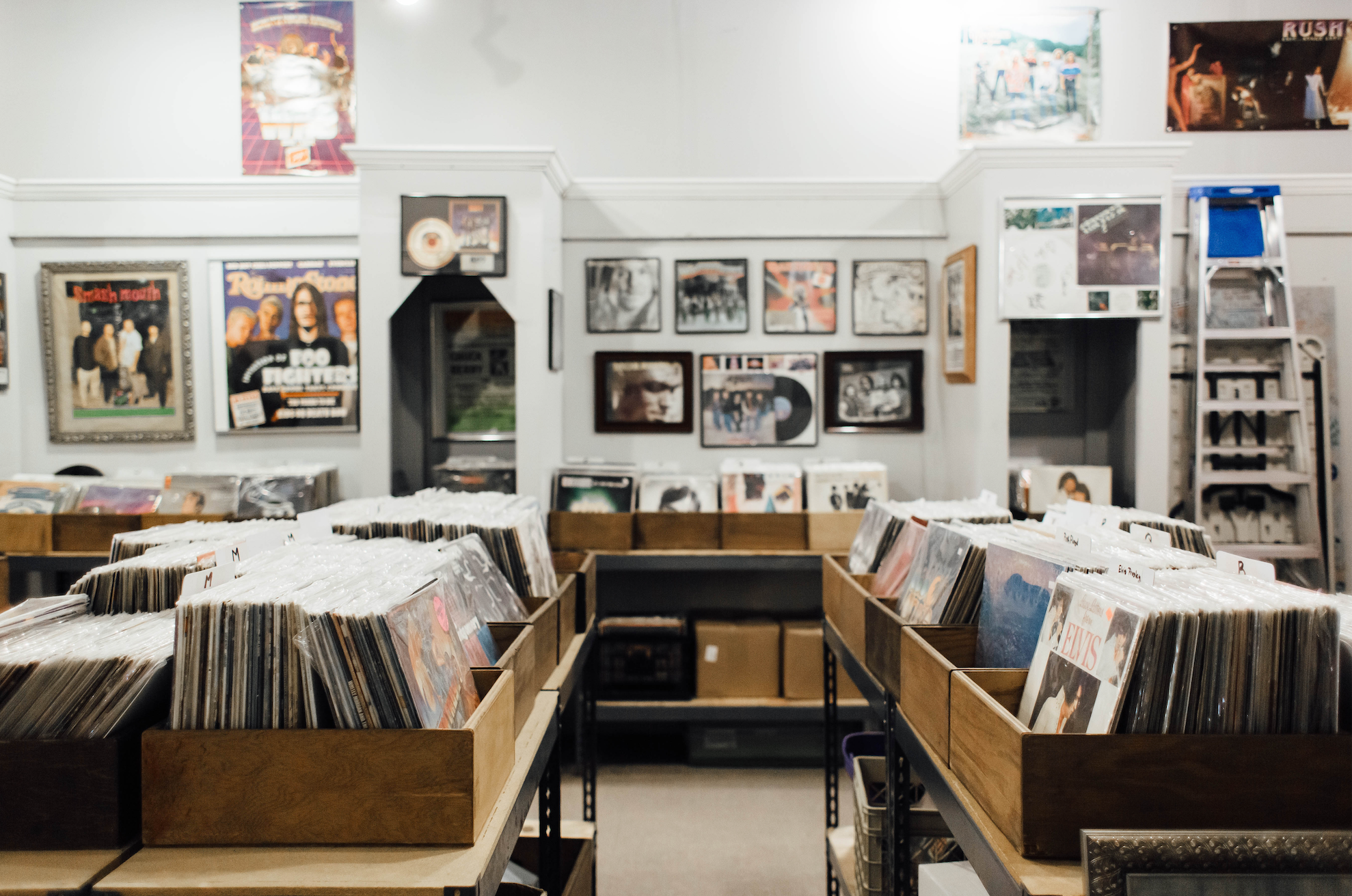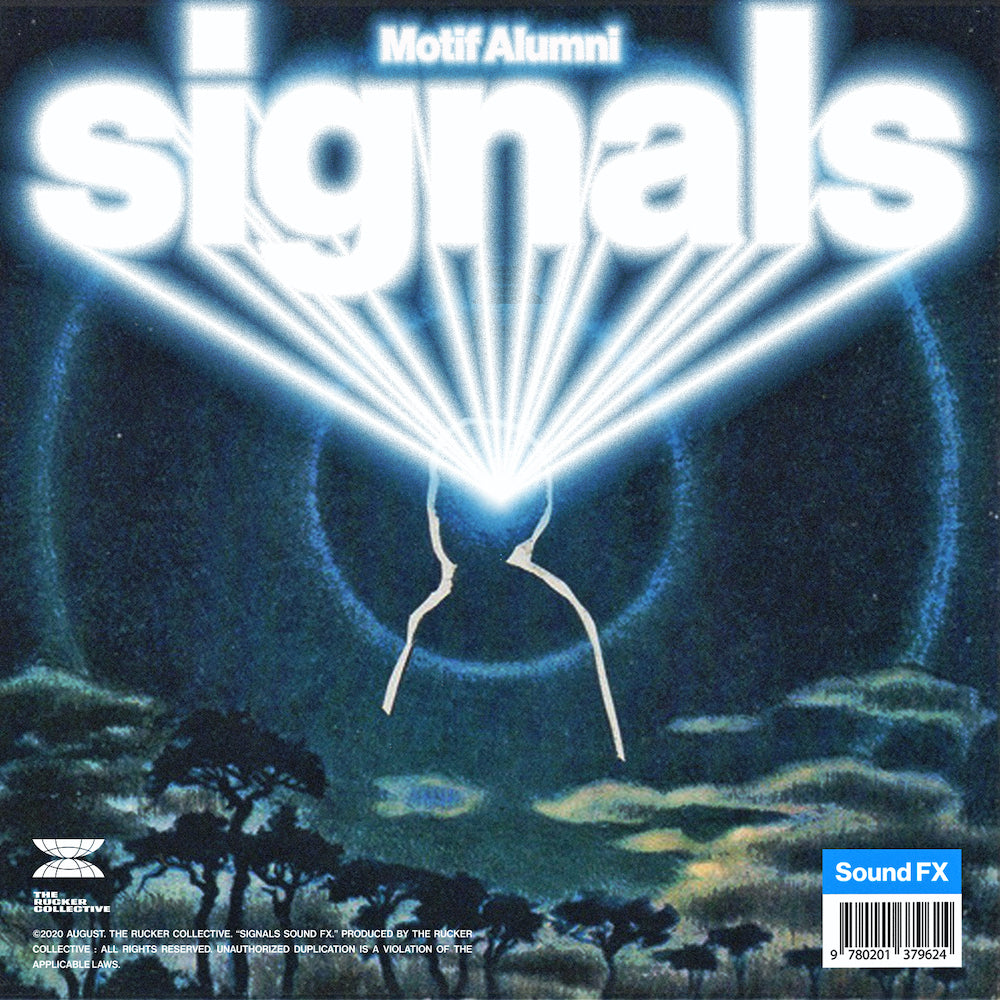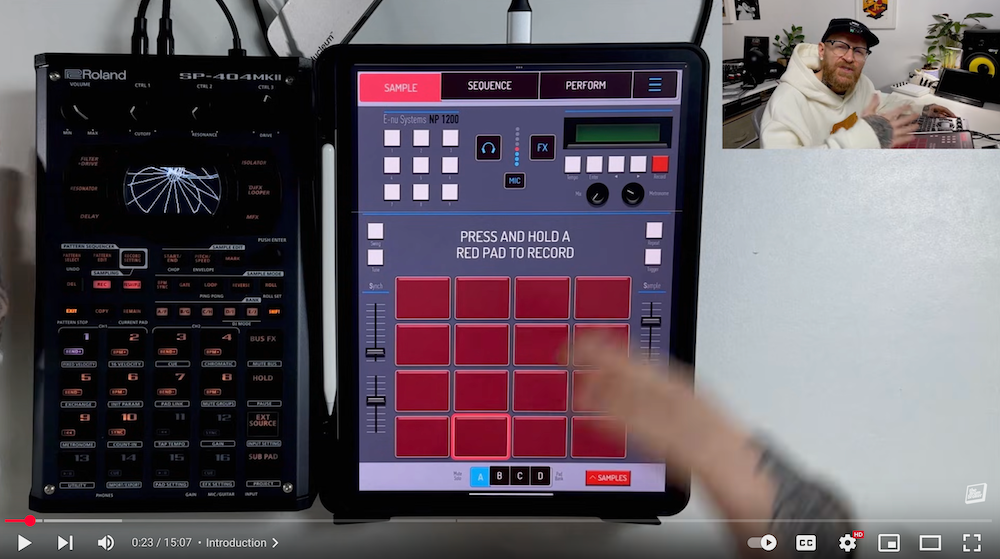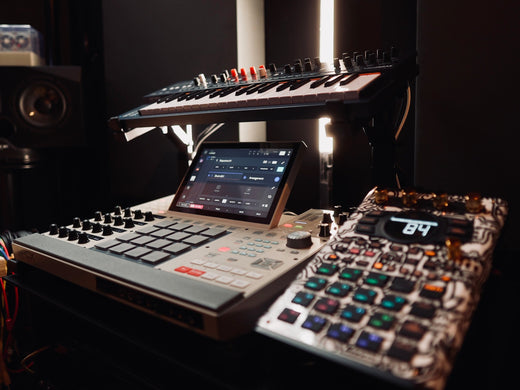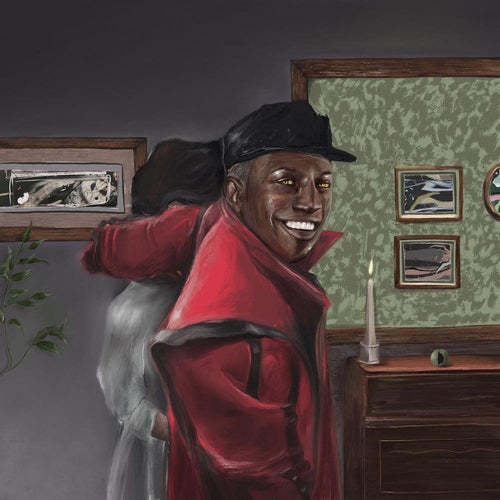Two Terabytes to DB Looper: Natekizbeats’ Creative Leap with The Drum Broker
When Nate Kiz opened the Dropbox link from The Drum Broker, he wasn’t prepared for what stared back: nearly two terabytes of drums and samples, a digital crate-digger’s dream and nightmare. To make sense of it, he worked out a simple formula for DB Looper: each beat would be built from one melodic sample and one drum sample. The catch was that those elements could never come from the same pack. That way, even if he dipped into the same pack for another beat, the drums and melodies were always sourced separately, keeping every track unique. The result was DB Looper, an album built entirely from Drum Broker sounds where Nate stepped away from his usual micro-chopped style to embrace looping. But it wasn’t just drag-and-drop. He chopped many of the drum sounds into new patterns, layering his own swing into the project so that each track carried his fingerprint. The Early Days For Nate Kiz, beatmaking started long before DB Looper ever hit Bandcamp. His dad was a drummer, so music gear was always around the house. But instead of sitting at a kit, he got curious about how rhythms could be programmed. A bootleg copy of Fruity Loops 3 gave him his first taste of digital production. Around the same time, a PlayStation music game introduced him to sequencing in a different way. Those tools weren’t glamorous, but they made him realize he’d rather build the beats than rap over them. In the pre-YouTube era, learning production was slow and hands-on. Every problem meant trial and error: figuring out why samples didn’t line up, how to clean up muddy sounds, or how to make drums knock harder. “Everything took longer back then,” he says, “but those mistakes gave my beats a grit I still chase today.” Koala Sampler Eventually, he embraced new tools like Koala Sampler on iPad, drawn in part by learning that Madlib made beats entirely on his tablet. At first, he doubted a $5 app could compete with heavyweight DAWs. Now, nearly 1,000 Koala beats later, it’s his main weapon. “Koala lets me work anywhere: on the couch, in the car, even waiting in a parking lot,” he says. “It’s pure focus with zero bloat.” Flipping the Packs When the Drum Broker drop arrived, Nate Kiz went straight for trusted names: • The Alchemist - Break Fluid and Soundbytes • Beat Butcha - Filth Series • Jake One - Snare Jordan • Marco Polo - Signature drum kits • Select gems from Soul Surplus and Kingsway Music "I wanted each beat to feel unique, so even if I pulled from the same pack twice, I never took both the drums and melody from it on the same beat. The drums always came from a different source, or vice versa. That way, each track still had its own DNA,” he explains. “Once I picked my melodic loop and drums, I’d just start building. No second-guessing." The Concept The name DB Looper wasn’t just a clever play on “loops.” It carried a story. Nate explained that he always liked the mystery of DB Cooper, the infamous hijacker who vanished in the 1970s after parachuting from a plane with stolen cash. For his project, he flipped that myth into a producer’s tale: DB Looper is a character who breaks into The Drum Broker vault, steals two terabytes of samples, and disappears into hiding. On the album, that story plays out in beats, skits, and visuals. Each track is like another page in the caper, with the character escaping the scene, finding refuge on an island, and building a new identity out of the sounds he stole. “I wanted it to feel like you’re following this character’s journey, not just listening to a beat tape,” Nate said. This narrative twist gave the project its identity. The “DB” in DB Looper became both Drum Broker and a nod to DB Cooper, while the “Looper” highlighted Nate’s decision to embrace loops over his usual micro-chopped approach. It’s more than just a project name: it’s a concept album built on myth, creativity, and the fun of reimagining history through hip hop production. For Nate, DB Looper wasn’t just about beats or loops. The story gave him a canvas to experiment with visuals, skits, and animation that carried the project further. More Than Music, A Story in Loops DB Looper isn’t just an audio project, it’s a multimedia concept. Nate Kiz expanded the world with storytelling, voice acting, and animation, giving the release a distinct visual identity. His growing animation skills fed into skits, promo videos, and stickers, and he’s experimenting with collaborations to keep pushing boundaries. “I don’t just want people to hear this project,” he says. “I want them to step into its world.” Why Koala Sampler Koala’s simplicity and portability made DB Looper possible in ways no other setup could. The app strips beatmaking down to essentials which include sampling, chopping, sequencing without the clutter of a full DAW. But that minimalism comes with quirks. Sequencing can be tedious, and without traditional quantization, mistakes sneak in. Instead of fighting them, he leaned in. The swing and off-kilter feel became part of the project’s character, making the loops feel alive. To expand Koala’s sonic palette, he paired it with the AUM app, running loops through effects chains that added grit, texture, and depth. This workflow let him blur the line between lo-fi and polished. Nate also relied heavily on BABY Audio’s FX Plugins as well as FabFilter’s Limiter for the project, which helped him polish the mixes. The biggest shift, though, was freedom. Koala let him make beats anywhere: sketching on the couch, finishing chops in the car, even sneaking in a loop while his child napped. “Sometimes I only have 15 minutes,” he says. “But with Koala, I can get an idea out before it disappears.” Goals Beyond DB Looper Looking forward, Nate Kiz aims to release four projects a year, whether solo beat tapes, full collaborations with rappers, or producer-to-producer joint efforts. He’s also working toward launching his first sample pack, built from field recordings, contact mic experiments, drum loops, and melodies crafted with boutique gadgets. His ambition isn’t about chasing placements, it’s about creating complete, self-contained works that reflect his vision. Hear the Project for yourself: DB LOOPER on bandcampDB LOOPER on SpotifyDB LOOPER on Apple Music Follow Nate Kiz on Instagram: @Natekizbeats
Watch Oscar Zulu Flip Original Soul Samples Into A Griselda-Style EP (Beat Breakdown)
In this video, Oscar Zulu breaks down his full creative process for crafting a Griselda-style EP from scratch—using only one sample pack: Mahogany Segments Vol. 2. From dirty drum breaks and soul samples to gritty basslines and haunting vocals, Oscar takes you inside the studio to show how he built 5 skeleton beats inspired by Westside Gunn, Conway the Machine, Benny the Butcher, Stove God Cooks, and other legends of underground coke rap. Featuring samples reminiscent of The Alchemist, Daringer, and Knxwledge, this pack is a goldmine for fans of that luxurious grime sound. Perfect for producers aiming for that Griselda, Boldy James, or Freddie Gibbs vibe. Download the Sample Pack Here: Square One Shots - Mahogany Segments Vol. 2
From Pandemic Garage to Global Inspiration: The Rise of Hip-Hop’s Malo
Stuck in a garage during the pandemic, hip-hop beatmaker Malo reignited his passion for vinyl sampling and transformed it into a thriving online community. Explore how an undying love for gritty loops, classic MPC workflows, and honest storytelling turned a moment of crisis into a worldwide musical inspiration.
Uncovering Griselda’s Grimy Sound: 10 Standout Tracks with Rare and Obscure Samples
Rare Soul and Library Music Goldmine From forgotten soul 45s to vintage library music, Griselda Records keeps the art of crate-digging alive. Westside Gunn, Conway the Machine, Benny the Butcher, and Boldy James have all found success riding the dusty grooves laid down by Daringer, The Alchemist, Apollo Brown, and others. These producers fearlessly flip obscure samples—some uncleared—in ways that sometimes get mixtapes pulled from streaming, but their dedication to rare sample-based production defines Griselda’s raw, street-savvy sound. Read on for a breakdown of 10 standout tracks and the hidden gems that brought them to life. 1. “Mr. T” – Westside Gunn Producer: Apollo BrownAlbum/Year: FLYGOD (2016, independent) Original Samples: “Under My Wings” by The Smith Connection (1972) – Apollo Brown laid the foundation of the track by chopping and looping this tender soul ballad. The warm vocals and lush instrumentation evoke a nostalgic, heartfelt vibe that has become synonymous with many Griselda beats. “Show Me How” by The Emotions (1971) – Briefly appears in the outro, adding a final touch of vintage R&B flavor. The mellow, dusty textures on “Mr. T” perfectly complement Westside Gunn’s gritty vocals, showcasing Griselda’s commitment to rare soul digging and sample-based hip-hop. As this was an indie release, these loops were likely uncleared—demonstrating how Griselda doesn’t shy away from using hard-to-clear samples in pursuit of that authentic, raw sound. Apollo Brown Drum Kits For producers looking to capture Apollo Brown’s signature punch and warmth, be sure to check out his official drum kits. They feature many of the percussive elements that give his beats that unmistakable dusty knock heard throughout his catalog. 2. “Niagara Café” – Westside Gunn Producer: SadhugoldMixtape/Year: Hitler Wears Hermes 6 (2018) Original Sample: “Seacoast” by Archie Whitewater (1970) – An obscure jazz-rock instrumental. Sadhugold lifted a haunting horn and keyboard riff, looping it to set an eerie, cinematic tone. The sample’s moody 1970s vibes embody Griselda’s approach: digging into non-traditional genres to find unique sounds that most producers overlook. 3. “Connie’s Son” – Westside Gunn Producer: King JVY BMixtape/Year: Hitler Wears Hermes 7 (2019) Original Sample: “I’ll Step Aside” by Moments of Truth (1968) – A sweet soul tune from the late ’60s, chopped and slowed down to create a dreamy but gritty loop. The melancholic melody perfectly underscores Westside Gunn’s verses. Fans often cite this as one of Griselda’s most beautiful flips, illustrating their knack for transforming rare soul cuts into hard-hitting street anthems. 4. “Lucha Bros” – Westside Gunn feat. Curren$y & Benny Producer: The AlchemistAlbum/Year: Hitler Wears Hermes 7 (2019) Original Sample: “A Colourful Dream” by The David Bendeth Band (1981) – A lesser-known jazz-funk piece from the early ’80s. The Alchemist, known for flipping rare samples, took the mellow saxophone and keyboard groove and repurposed it into a hazy loop. The funky bassline and airy melody create a laid-back atmosphere for Westside Gunn, Curren$y, and Benny to deliver their verses. The result is a smooth yet gritty track that demonstrates The Alchemist’s knack for uncovering hidden gems. If you’re inspired by his production style, check out his drum break kit Break Fluid, which offers that signature dusty swing and punch heard in many of his classic beats. This kit reflects the same attention to detail and ear for unique textures that make “Lucha Bros” stand out in Griselda’s discography. 5. “The Cow” – Westside Gunn feat. Conway the Machine Producer: DaringerAlbum/Year: FLYGOD (2016) Original Sample: “A Plague of Lighthouse Keepers” by Van Der Graaf Generator (1971) – A 23-minute prog-rock epic from a British band. Daringer zeroed in on a chilling organ and vocal segment, looping and filtering it to craft a droning, ominous backdrop. This dramatic, mournful tone is perfect for Conway’s emotional verse about street trauma—proving that Griselda’s producers will pull from any genre if it fits their dark, gritty aesthetic. 6. “Rubber Bands & Weight” – Benny the Butcher Producer: The AlchemistAlbum/Year: Tana Talk 3 (2018) Original Sample: “Morgue Line Up” by John Cameron (1973) – A piece of soundtrack/library music from the British horror film Psychomania. The Alchemist restructured the creepy instrumental, with its swirling strings and eerie ambiance, into a tense, cinematic beat. It’s a prime example of how Griselda beats thrive on haunting loops and dark atmospheres. 7. “200 Pies” – Conway the Machine feat. 2 Chainz Producer: The AlchemistAlbum/Year: La Maquina (2021) Original Sample: “Can’t Be Alone” by Hodges, James & Smith (1973) – This obscure soul track by a female R&B trio features dramatic intro strings and vocals. The Alchemist chopped and repurposed them into a stirring backdrop for Conway and 2 Chainz 8. “Sunday School” – Benny the Butcher feat. 38 Spesh & Jadakiss Producer: DaringerAlbum/Year: The Plugs I Met EP (2019) Original Sample: “Sunday Song” by Richie Beirach (1978) – A deep jazz cut from pianist Richie Beirach. Daringer loops its gentle piano and synth notes, layering them into a soulful boom-bap beat that feels both vintage and fresh. 9. “Photographic Memories” – Boldy James & The Alchemist feat. Earl Sweatshirt & Roc Marciano Producer: The AlchemistAlbum/Year: Bo Jackson (2021)Original Samples: Vocal snippets from the George of the Jungle (1967) cartoon and Stand by Me (1986 film). These eerie refrains add a haunting vibe, showcasing how Griselda producers can flip not just musical sources, but also movie and TV dialogues into atmospheric loops. 10. “Carruth” – Boldy James Producer: The AlchemistAlbum/Year: The Price of Tea in China (2020) Original Sample: “Who Is That Man” by The California Earthquake feat. Roy Smith (late 1960s) – A rare soul/psych track. Alchemist lifted a chilling piano riff and woozy vocal to construct a slow-burning, menacing groove—perfectly matching Boldy’s understated yet vivid lyricism. Why These Samples Matter to the Griselda Sound From obscure prog-rock symphonies to 1970s soul ballads, Griselda takes hip-hop back to its roots in sample-based production. Their reliance on hard-to-find loops—cleared or not—hearkens to a golden era of crate-digging, where producers transformed hidden gems into raw, heartfelt instrumentals. This dedication to discovering forgotten music is what imbues Griselda’s output with such a unique, gritty texture. If you’ve ever wondered how those signature “Griselda drums” and soulful chops come together, a closer look at these original vinyl cuts will reveal the collective’s blueprint. For fans and fellow beatmakers, it’s an inspiring journey through the building blocks of a modern hip-hop powerhouse.
Create Entire Beats with "Signals" | 100+ Royalty-Free SFX
Looking for a fresh approach to beatmaking? Signals by The Rucker Collective lets you do just that. Featuring over 100 royalty-free SFX from Motif Alumni, this pack is all about immersive ambience and unique sonic textures. Instead of just layering them in the background, you can actually build entire beats using these versatile sounds alone. Experiment with flipping SFX into melodic loops, morphing them into percussive elements, or stacking them for cinematic depth. Whether you’re venturing into new genres or perfecting your signature style, Signals is the go-to resource for dynamic production. Ready to break away from the norm? Unlock your creativity and craft fully realized tracks with the endless possibilities in Signals. Download Signals Now!
NervousCook$ Reviews Beat Butcha's 'Nourishment' Sample Pack on Koala Sampler
Join NervousCook$ as he dives into Beat Butcha’s Nourishment Vol. 1—a 2,001-sound monster sample pack bursting with dusty breaks, melodic chops, one-shot drums, and hi-hat loops. Covering genres from mainstream Hip Hop and Yacht Rock to Old School Afro and 80s Boogie, this pack is a treasure trove for producers looking to blend classic vibes with a modern twist. Using the Koala Sampler, NervousCook$ flips these samples live, crafting beats that inspire while showcasing the pack’s incredible versatility. Experience the creative process in action—from previewing and chopping samples to layering drums and finalizing a beat—and discover how every element comes together to fuel your musical creativity. Ready to start chopping? Download Nourishment Vol. 1 and explore more Beat Butcha Sample Packs to level up your beatmaking game.
Building Better Drums: A Conversation with Producer/Engineer Damon Flores
Building Better Drums: A Conversation with Producer/Engineer Damon Flores “I just want to provide for my family doing what I love.” – Damon Flores For years, Dutch producer and freelance IT specialist Damon Flores has juggled a career in tech while honing his craft in beatmaking and drum programming. He’s partnered with globally recognized sample creators, shared tips with fellow producers from around the world, and steadily built a reputation for lush, hard-hitting drum patterns that make people sit up and take notice. In our wide-ranging chat, Damon broke down his process for creating and mixing drums—both on the MPC and in Ableton Live—while reflecting on how he balances family life, IT work, and a passion for music. The Beats From IT to MPC: A Quick Background Growing up in the Netherlands, Damon bounced in and out of music throughout his life. Despite long spells away from production—prompted by family responsibilities or lack of inspiration—he always found himself gravitating back to beats. In 2019, right before the pandemic, he committed to going “all in,” investing in his setup and dedicating daily time to refine his sound. Four years later, that effort has paid off. Damon’s beat videos have reached an international audience that often mistakes him for a New York-based producer, thanks to the New York-influenced grit of his drums and the high production value of his video content. He’s quick to emphasize that “If you want something to be great, you have to invest in yourself and your gear.” Drums on the MPC: One-Shots and Breaks Damon’s approach on the MPC can be split into two primary methods: using one-shots and chopping drum breaks. Using One-Shots Building the Drum Program Damon starts by loading an empty drum program with carefully selected kicks, snares, hats, and occasional percussion. Sometimes these one-shots come straight from his library; other times, he routes them through the SP-404 first for some character.A dedicated “ghost kick” pad is crucial to Damon’s workflow, sitting at a lower volume and rolled-off high end. “The ghost kick keeps the groove breathing,” he explains. He also sets his main kick as a sidechain input for the Mother Ducker plug-in. Staying in tune is important, and Damon often tunes his Kick drum to the sample or melody as needed Sequencing & Groove He typically finger-drums a 4-bar loop and, on the final bar, either strips out the main drum hits or adds a quick fill for variety. Subtle nudging of the snare and ghost kick helps achieve an off-grid swing. For hi-hats, he’ll use the MPC’s humanize function to randomize velocities and avoid sterile repetition. Color & Cohesion Plug-ins like Air Flavor Pro add warmth or vintage flair. If the drum track needs extra glue, he’ll apply gentle bus compression on the entire drum program. Chopping Drum Breaks Slice and Shuffle Damon chops breaks into quarter-note slices (or smaller) to rearrange them freely. After slicing, he may boost or soften individual hits. Layering & Pitch If a break’s hi-hats feel under powered, he layers them with additional hats or percussive loops. Pitch adjustments (up or down) further personalize the break. Favorite break sources include Bizkel, Beat Butcha, and Skyking—all known for distinctive textures. The Ableton Live Workflow Though the MPC remains a cornerstone of Damon’s style, Ableton Live has carved out a permanent space in his production process. He’s been using it since 2010 and loves Push and the new Ableton Move for hands-on control and faster sample manipulation. Drum Rack Setup In Live, Damon loads one-shots into an empty Drum Rack, keeps velocity fixed for kicks and snares, and allows dynamic variation for hi-hats. He maintains a pad specifically for ghost kicks—“It’s essential,” he says. EQ Eight is used to roll off lows on hats and snares, ensuring clarity in the lower frequency range. Groove Pool Magic Damon often experiments with the Groove Pool, selecting classic MPC 3000 or SP1200 swing presets to add an old-school feel. Colorful Plug-ins Among his favorites are RC-20, Soundtoys Decapitator, KNOCK, and Serato HEX. “HEX feels more modern. You can dial in grit on the fly,” he notes. For cohesive bus processing, he often turns to Ableton’s Glue Compressor, Goodhertz Vulf, or the SSL Bus+ for a final polish. Using Breaks in Live Damon’s process with breaks in Live echoes his MPC routine: slicing into a MIDI track, rearranging hits, and tweaking pitch or layering additional percussion for unique character. He might also push the break through the SP-404 or Analog Heat for extra saturation. “Sometimes if the drums are too clean, you need that analog gear to give it bite,” he explains. External Gear and That “Secret Sauce” While many producers rely purely on software, Damon prefers a hybrid setup. He frequently runs the master output from his MPC or standalone samplers through an Elektron Analog Heat and SSL Fusion, adding harmonic saturation and analog warmth before finalizing tracks in Ableton. The SP-404 also comes into play for vinyl simulation, compression, and that distinctive lo-fi texture. “I like it when the sample pack maker leaves a bit of headroom—if it’s too loud from the start, I can’t add my own sauce.” Less Is More In a world over-saturated with plug-ins, sample libraries, and social media “hustle culture,” Damon takes a more restrained approach. “If it sounds good, it’s good. Don’t overthink it,” he says. He admits to owning a stack of unused plug-ins but notes that he returns to the same few tried-and-true tools over and over again. He also stresses consistency over constant pressure: “I used to post two beat videos a day, every day, even while moving into a new house. Now I’ve got a more balanced system—work smarter, not harder.” Final Thoughts For Damon, the goal is simple: make great-sounding drums that knock, while keeping the creative spark alive. Whether he’s finger-drumming on the MPC, layering a break in Live, or running everything through outboard gear for extra grit, the key ingredient is always his ears—and a willingness to experiment. “One day I might focus on a single break; the next, I’m layering 32 sample chops. If it fits the track and makes my head nod, I roll with it.” To keep up with Damon’s drum experiments, follow him on Instagram or Spotify—and be on the lookout for more behind-the-scenes posts on drum production, gear talk, and everything in between. Follow Damon Flores on Instagram Follow Damon Flores on Spotify Disclaimer: All brand and product names (MPC, SP-404, Ableton Live, etc.) are the property of their respective owners. No official affiliation or endorsement is implied.
Conductor Williams Discusses the Art of Sampling
Griselda Records Producer Discusses the Art of Sampling Introduction “Peace man, peace man, peace—back at it. The Conductor chops…” That’s how Conductor Williams kicks off his laid-back yet deeply insightful discussion on the art of sampling. If you’ve followed his rise—especially through his work with Griselda—you know that his unorthodox methods and unbridled enthusiasm give him a one-of-a-kind style. In this post, we’ll dive into Conductor Williams’ journey: discovering sampling, working with Westside Gunn, and chasing the “feeling” in every record he flips. A Chance Encounter With the MPC Conductor recounts the day his friend Cali Nate brought an MPC 2000 into his house: “He just sat it down in front of me…I had no idea what he just put in front of me. It was like some alien contraption.” At that time, Conductor was already making music with a Korg Triton LE, but the MPC opened the door to an entirely new way of producing. This wasn’t simply about pressing keys—it was about grabbing sound from any source imaginable and molding it into something fresh. Learning by Experimentation After figuring out how to capture sound through the MPC’s inputs, Conductor took a childlike, experimental approach. He explains: “I knew how to get sound in it, so let’s see what happens if I hook a VCR up…or a CD player.” Plugging in random devices taught him that the possibilities in sampling were limitless. He emphasizes that, in the beginning, he was clueless yet open—he didn’t have years of YouTube tutorials or producer forums. Instead, he tapped into raw curiosity and allowed mistakes to guide him to new textures and ideas. Finding a Sample: It’s About Feel A critical piece of advice Conductor gives is that it’s not about chasing a specific sample style, but rather trusting your intuition: “I don’t look with my eyes or my ears. I look for something that feels like how I’m feeling in that time.” He describes days where he’s just not in the mood for a classic soul record—so he shelves it and moves on to something that resonates more deeply with his current vibe. In his view, forcing yourself to work with a sample or a genre you’re not feeling leads to writer’s block and frustration. Instead, pivot to where your energy naturally flows. How He Linked With Griselda Surprisingly, Conductor’s connection to Griselda came about organically. Westside Gunn discovered him through Instagram: “Westside Gunn found me on Instagram—don’t know how he did it to this day—and I was ready. That’s basically it.” The moral of the story? Always be prepared. Conductor mentions he already had a Dropbox full of beats ready to go, allowing him to strike while the iron was hot. Developing a Signature Style While Conductor humbly credits “dumb luck” and experimentation, his true secret sauce is consistency and authenticity. He follows his muse day-to-day, letting that flow dictate his sampling decisions. Whether he’s chopping up a thrift-store vinyl find, hooking up a vintage keyboard, or sampling from a film on VHS, he’s driven by feel rather than trends: “The innocence of not knowing but being willing to experiment is how you get magic.” It’s a refreshing reminder that having fun is at the core of true creativity. Applying Conductor’s Approach Although Conductor Williams first honed his craft on the MPC, his free-spirited, feel-driven approach translates seamlessly to Ableton Live, FL Studio—or any modern DAW. It begins with capturing any and all sounds that spark inspiration. Maybe it’s vinyl, an old VHS player, your phone, or an obscure YouTube video—whatever triggers that creative spark. Once recorded, focus on finding the right texture by dropping your audio into Simpler or Sampler, then playing around with filters, envelopes, and LFOs. Don’t be afraid to embrace serendipity; set aside dedicated sessions to experiment, toss on unexpected effects, reverse clips, and let yourself fail before judging the results. If a particular sample isn’t aligning with your mood, move on—try something else that resonates emotionally. Finally, always keep a stash of loops, skeleton beats, or halfway-finished projects so you’re never caught off guard when opportunity strikes. When it comes to sampling, Conductor’s secret sauce is simple yet powerful: capture everything, trust your feelings, and stay ready.

